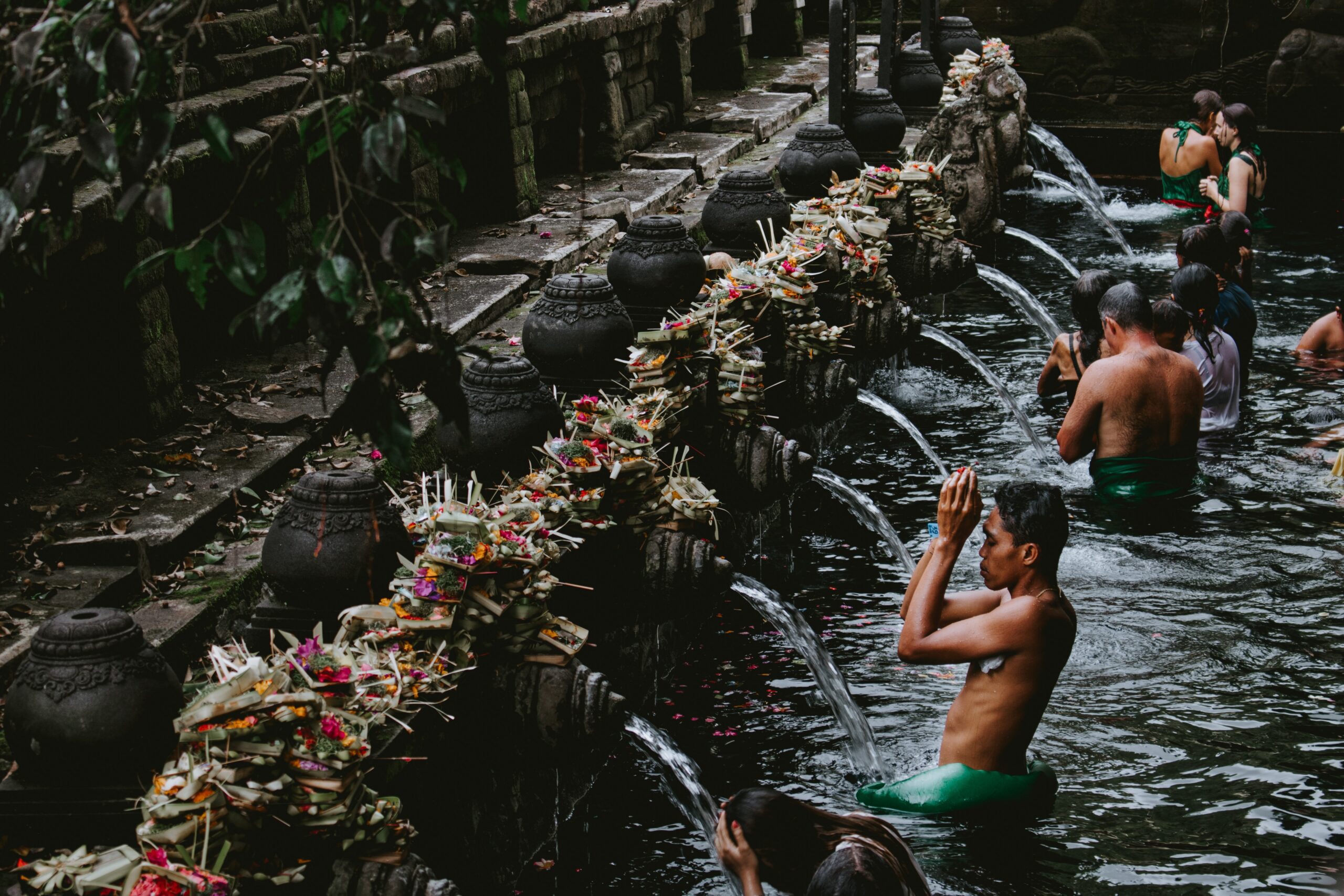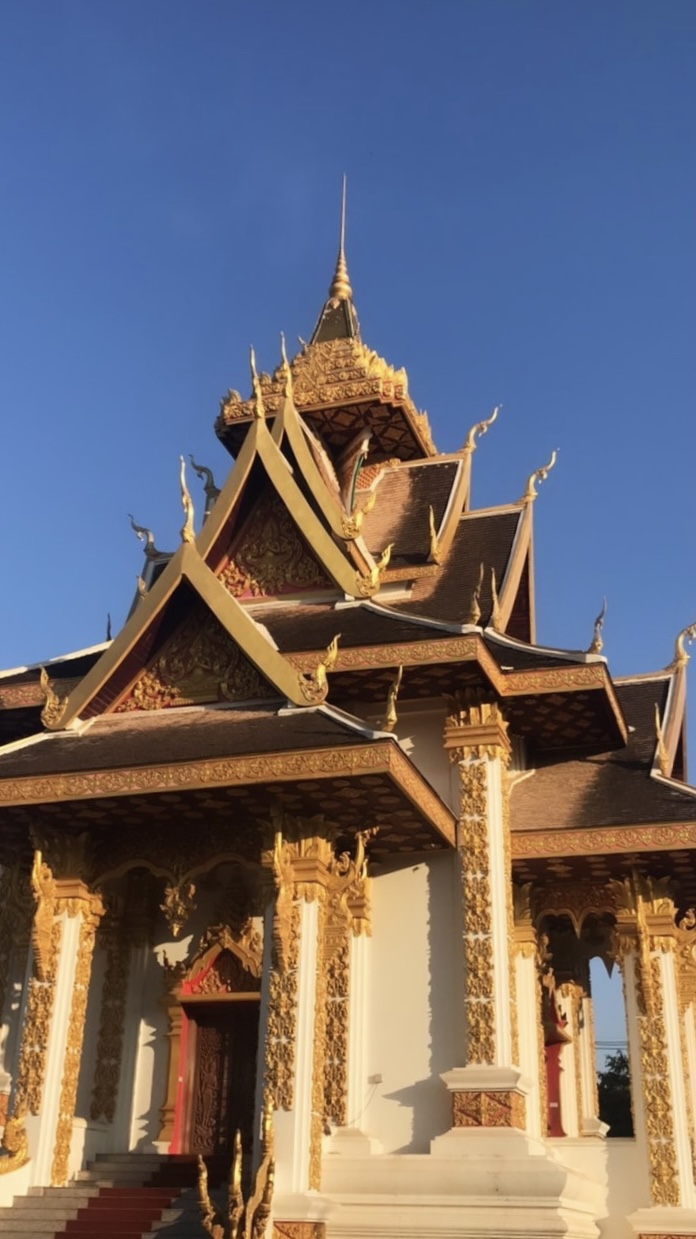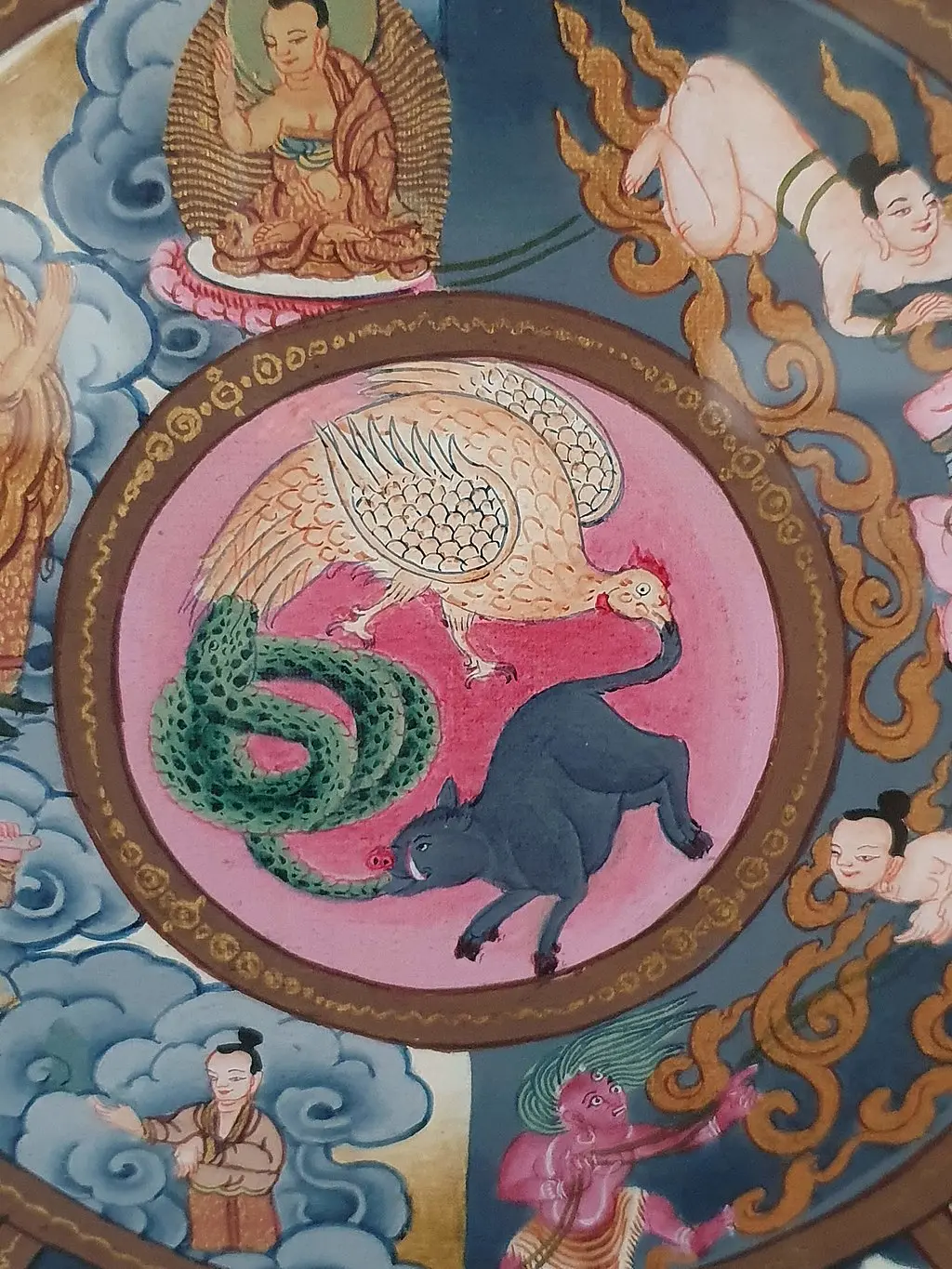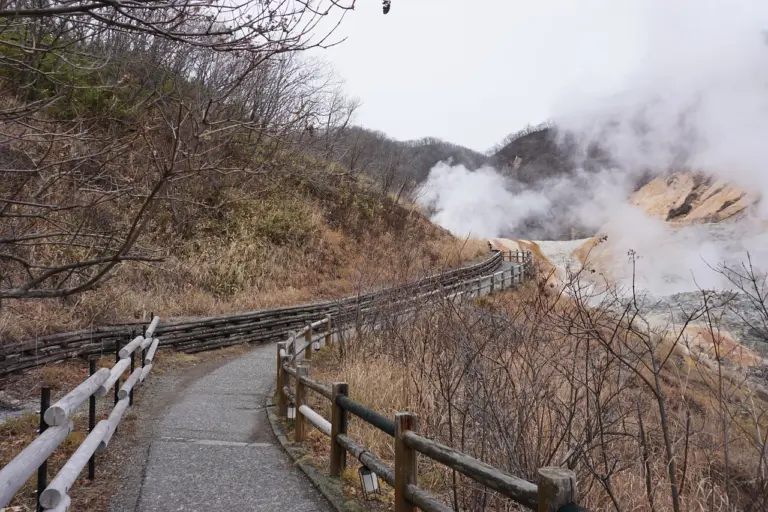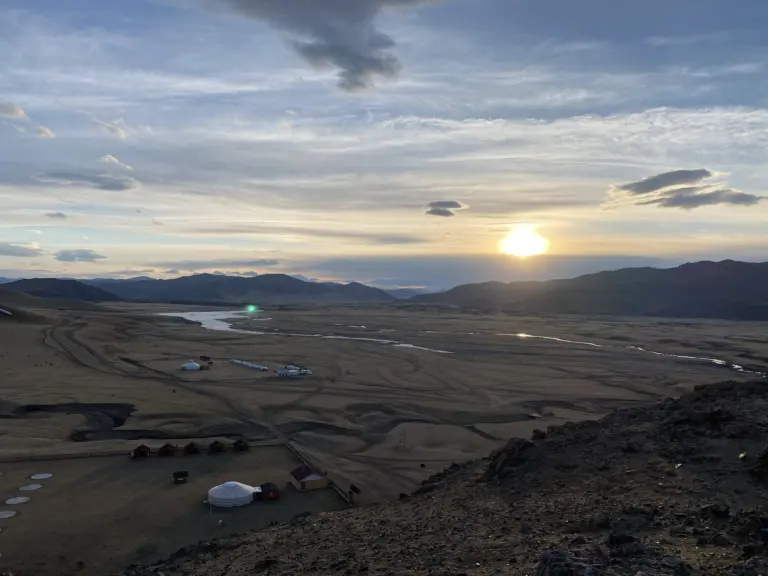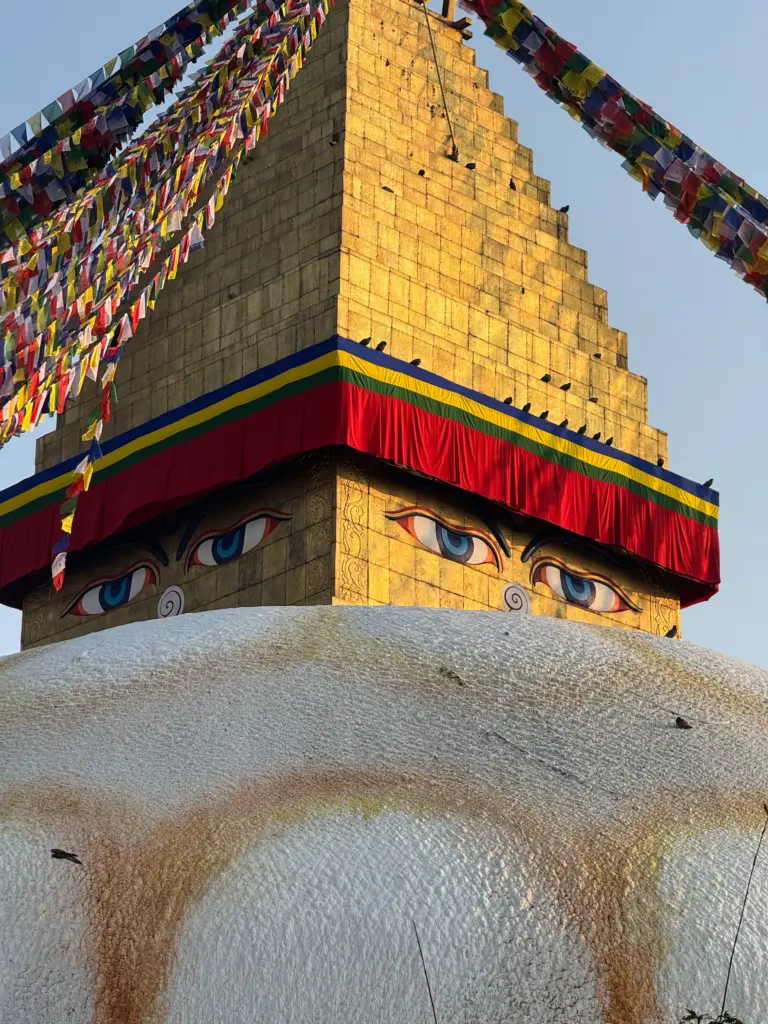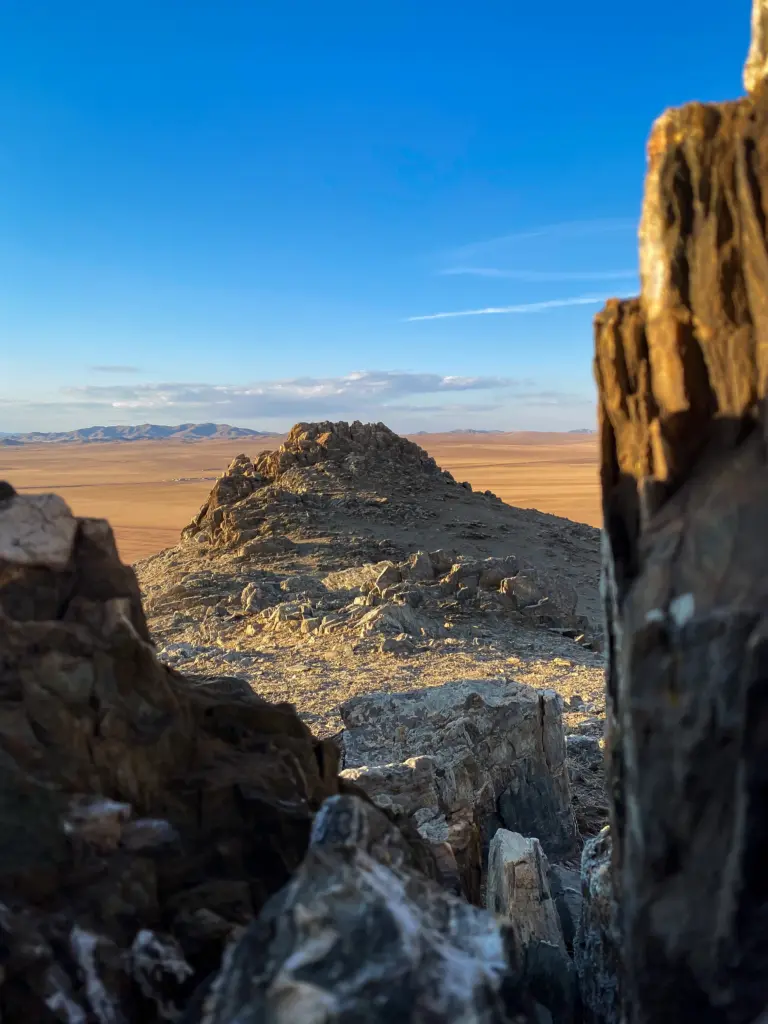Chiang Rai is the hidden jewel of Thailand. A captivating city that has yet to be fully discovered by many travelers. Despite its relative obscurity, it’s gaining popularity due to its awe-inspiring modern temples that are unlike any other in the world.
Chiang Rai is also nestled in bountiful natural surroundings with mountains and waterfalls which makes it a perfect destination for nature-lovers.
With both Buddhism and nature at its core, it’s no surprise why Chiang Rai deserves a place in anyone’s Thailand itinerary! In this travel guide, we’ll be going through the best places and things to do while you’re in this provincial paradise.
Table of Contents
Toggle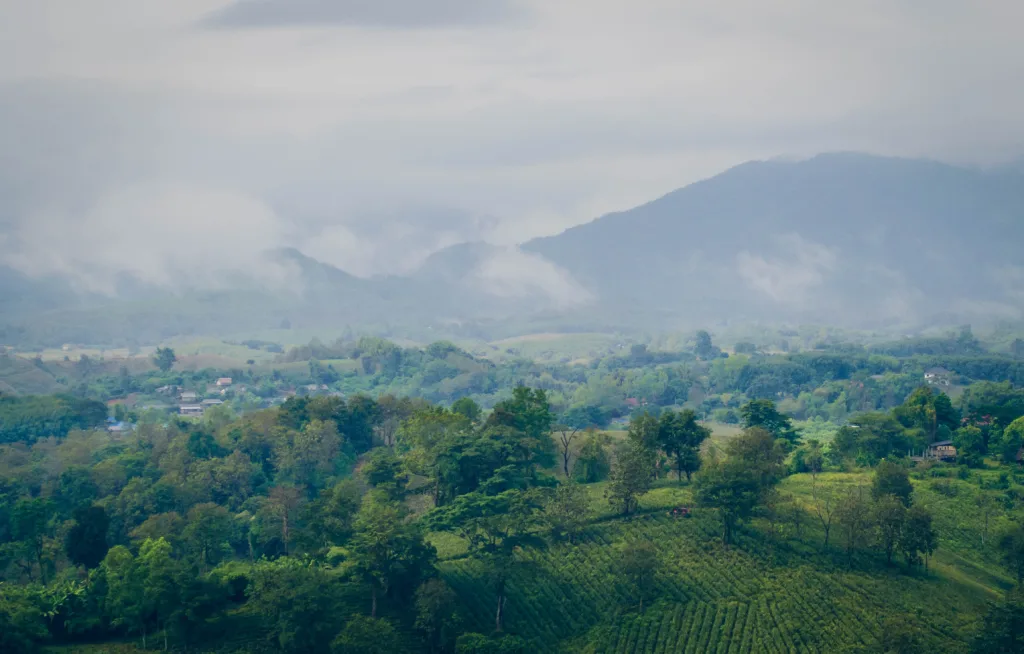
History of Chiang Rai
Chiang Rai is a province located in the northernmost part of Thailand. It is one of the oldest settlements in Thailand with a rich history that dates back more than 700 years.
Chiang Rai was originally known as “Yonok” and was ruled by the Lanna Kingdom until it was conquered by the Burmese in the 16th century.
In the late 18th century, Chiang Rai was brought under the control of the Chao Phraya Chakri Dynasty, the same dynasty that ruled the Kingdom of Siam (modern-day Thailand) from 1782 until 1932. During this time, Chiang Rai became an important trading center for opium (it is part of the infamous “Golden Triangle.”) Nowadays, instead of opium, you can find cannabis pop-up shops around Chiang Rai.
Today, Chiang Rai is quickly gaining traction as a popular tourist destination due to its unique temples which we will get to know some more throughout this article.
How to Get to Chiang Rai from Bangkok
There are several ways to get to Chiang Rai from Bangkok:
- Plane: The most convenient way to get to Chiang Rai from Bangkok is by plane. The flight time is approximately 1 hour and 15 minutes and goes straight to Chiang Rai International Airport.
- Train: There’s actually no train station in Chiang Rai so you’ll have to take a train to Chiang Mai first and then take a bus to Chiang Rai. The train will take around 11 – 13 hours and the bus will take another 3 hours.
- Bus: Taking a bus from Bangkok to Chiang Rai will bring you to the bus station 7 km (4 mi) south of Chiang Rai. You will then have to take a songthaew (shared taxi) that will cost around 15 THB (0.40 USD). From Bangkok, the journey takes about 11 hours so I recommend taking the night bus.
- Car: It’s also possible to rent a car to explore Thailand, the roads are quite safe and well-developed. The journey will still take you around 11 hours or so but there is much freedom and you can stop by anywhere you please.
Best Places to Visit in Chiang Rai
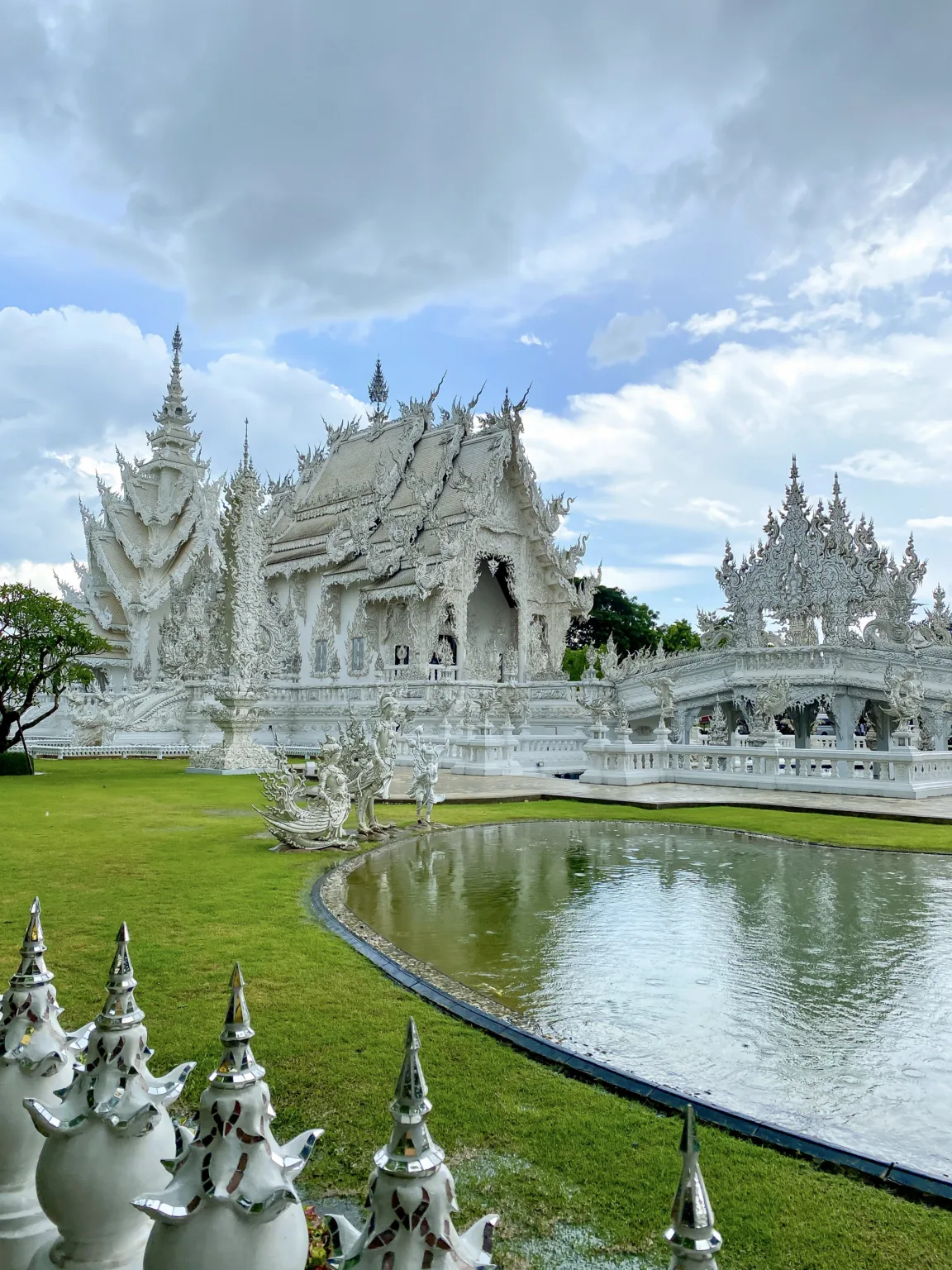
1. Wat Rong Khun (The White Temple)
Wat Rong Khun, also known as the White Temple, is by far the most famous attraction in Chiang Rai. This temple is a unique blend of traditional Thai architecture and modern design, and its radiating beauty draws people from all over the world.
Pictures don’t really do it justice and when we were there, I was truly left in awe at just how intricate the details are. From the fire-shaped roof, to the spiky fence, and the surrounding white buildings, it will feel like you just stepped into another world.
The temple was designed by Chalermchai Kositpipat, a renowned Thai artist who wanted to create a temple that would not only be a place of worship but also a work of art. The exterior of the temple is entirely white, which represents the purity and wisdom of the Buddha.
The most photogenic spot has to be the bridge that leads to the main temple. The bridge is designed to represent the cycle of rebirth, so it has you crossing over from the realm of the living to the realm of the dead before entering the temple. The scary hands gripping at both sides of the bridge symbolize desire.
If you want to know more about the symbolisms of the White Temple to enhance your visit, you can check out my blog post here.
Cost: 50 THB (1.40 USD)
2. Wat Huay Pla Klang (The Big Buddha)
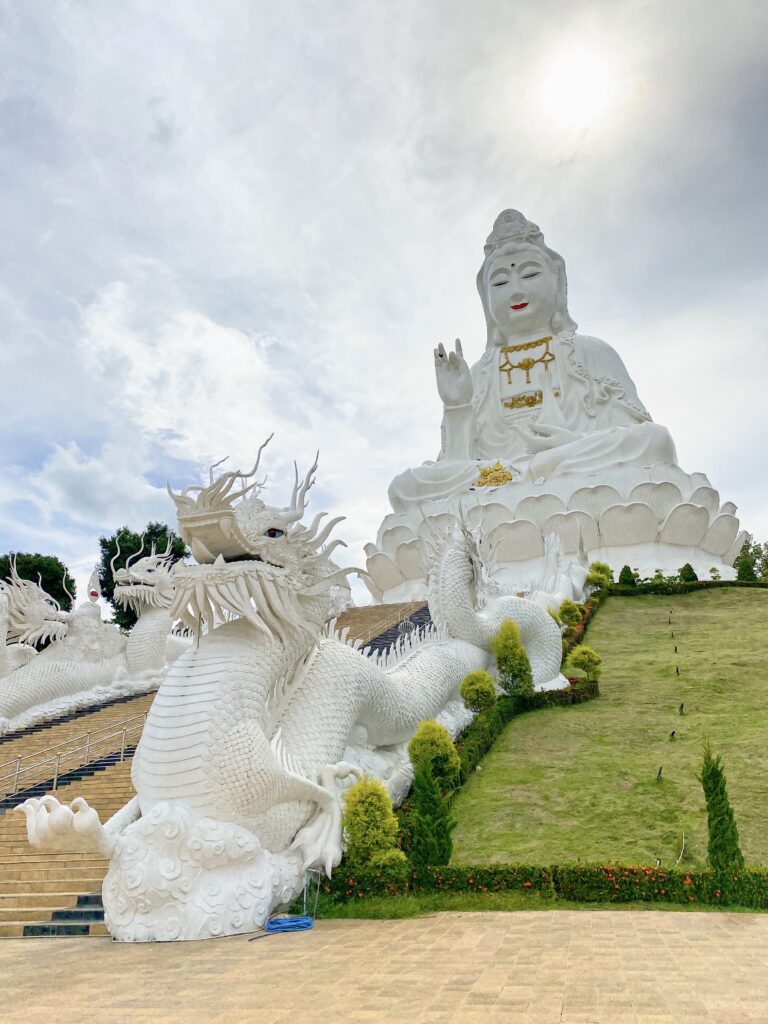

Wat Huay Pla Klang, also known as the Big Buddha, is a massive statue of the Goddess of Mercy. The statue is 79 m (259 ft) tall and is one of the largest Buddha statues in Thailand!
It’s still relatively new, having been built in 2008. The statue is located on top of a hill and can be seen from miles away. You have to climb several flights of stairs to get to the top but even that journey is quite fun as they have these giant white dragons at each side of the stairway.
While people have been calling it Big Buddha, her name is actually Guan Yin, the Goddess of Mercy and she is one of the most important deities in Mahayana Buddhism. She goes by many names depending on the country, Bodhisattva Avalokiteshvara (India), Chenzerig (Tibet), or Kannon (Japan).
The views from the top are also well-worth the climb, you can see a panoramic view of the surrounding mountains and you can pay a little extra to climb up to the top of the statue.
Cost: Free
3. Wat Phra Kaew (Temple of the Emerald Buddha)
Wat Phra Kaew or the Temple of the Emerald Buddha, is the most important and historic temple located in Chiang Rai. Not to be confused with the Wat Phra Kaew in Bangkok.
Both temples are actually the Temple of the Emerald Buddha. Let me explain, the temple dates back to the 14th century and was originally built to house the Emerald Buddha, which is now housed in Bangkok. The Emerald Buddha itself has had a tumultous history going all the way to Vientiane in Laos before coming back to where it is today.
Despite the fact that the original Emerald Buddha is no longer in the temple, Wat Phra Kaew remains a revered temple particularly among the locals. You can find a replica of the Emerald Buddha there instead.
Cost: Free
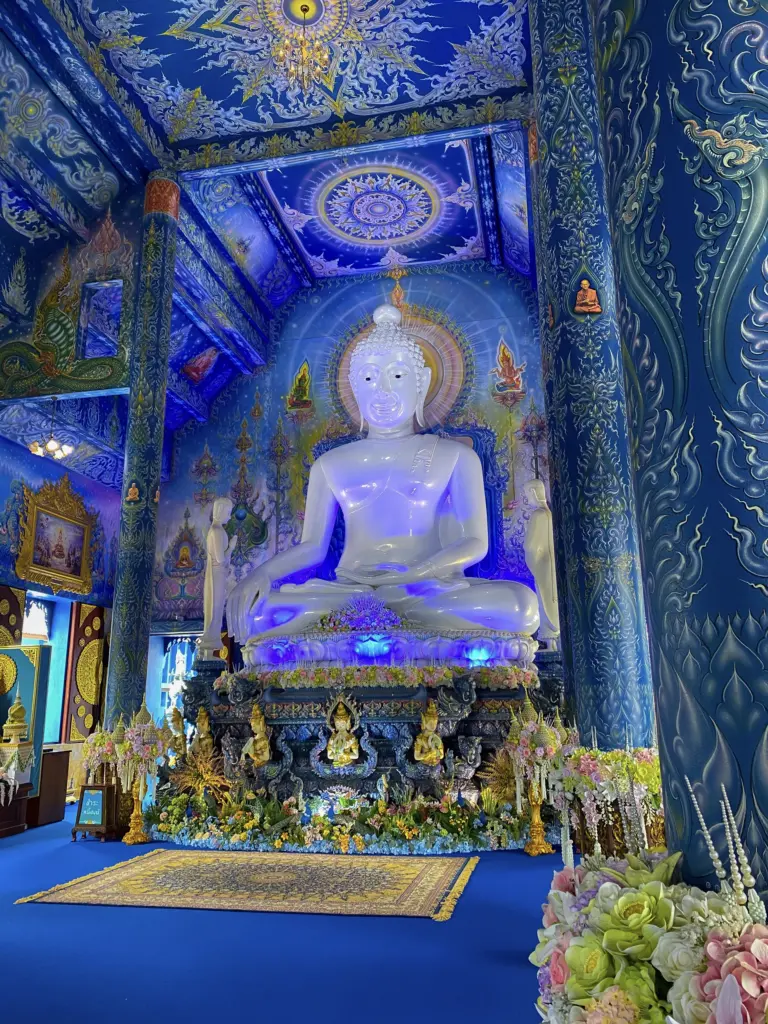

4. Wat Rong Suea Ten (The Blue Temple)
Wat Rong Suea Ten, commonly known as Blue Temple, is another beautiful temple designed by Chalermchai Kositpipat, the same artist who created the White Temple. Like most of the tourist spots in Chiang Rai, the Blue Temple is still new having been completed in 2016 but news of its splendor are quickly spreading.
The Blue Temple is aptly named as the temple’s exterior is painted in stunning shades of blue and gold, creating a striking appearance. The temple’s interior is just as beautiful, everywhere you look it’s coated in blue with a giant white-jade Shakyamuni Buddha statue in the front.
I particularly enjoyed just meditating here in such divine presence. Chiang Rai was really unique in their portayal of Theravada Buddhism, I’ve never seen such temples in any other countries. The surrounding walls actually depict the life of the Buddha with several recognizable scenes if you’re familiar with his story.
Cost: Free
5. Khun Korn's Waterfall
Khun Korn’s Waterfall is named after a local hero, Khun Korn.
The legend of Khun Korn tells of a time when the armies of the Mongol Empire were invading Southeast Asia. Khun Korn, who was a local leader and warrior, gathered his forces and led them into battle against the Mongol army. Despite being vastly outnumbered, Khun Korn was able to defeat the Mongols and drive them out of the region.
The waterfall is located in the Khun Korn Forest Park, a 40 minute drive from the city. You will have to do an easy hike but it’ll be all worth it as you’re greeted with the breathtaking sight of the 70 m (230 ft) waterfall cascading down into the swimmable pools below.
Cost: Free


6. Baan Dam Museum
The Baan Dam Museum, also known as the Black Houses, is a very surreal place. It’s not someplace I recommend taking children to. The museum was created by the late artist Thawan Duchanee, who is considered to be one of Thailand’s most important contemporary artists.
The Black Houses are a collection of over 40 different structures made from dark wood, all designed to showcase the artist’s distinctive style, something I would describe as a mix of macabre and sensual.
There were a lot of strange objects, a lot of dead things, skeletons, animal skins and what not. At the same time there were a lot of explicit objects, very “phallic” and they don’t hide that! All of these things were inside a guise of an almost spiritual-temple like atmosphere. Very strange but definitely worth seeing!
Cost: 80 THB (2.30 USD)
7. Mae Fah Luang Cultural Park
The Mae Fah Luang Cultural Park was established in 1977 by the late Princess Mother, also known as Somdet Phra Srinagarindra, the mother of the King Rama IX. (The name Rama comes from the Indian epic, Ramayana (the Thai version is called the Ramakien), which you will see in the murals of the Royal Grand Palace in Bangkok)
At first it functioned as a training camp for hilltribe youths that were tasked to lead their communities in royal projects. The training camp was then turned into a culture park to house collections of Lanna art.
The park is also known for the the Haw Kham (Golden Pavilion), which is an ornate building that houses a collection of traditional Thai artifacts.
Cost: 200 THB (5.50 USD)
Hidden Gems in Chiang Rai
8. Wat Tham Pla (Fish Cave Temple)
Wat Tham Pla also goes by the name Monkey Temple or Fish Cave Temple due to the fact of the presence of both animals. The temple is home to a huge population of Macaque monkeys, catfish and koi.
It’s quite small but still a pretty unique place to visit. The staircase is quite photogenic with its twin nagas (serpents) at both sides. You can also see a lot of mythological creatures such as the “Preta” which the Giant Swing in Bangkok’s Wat Suthat was mistaken for back in the day.
Cost: Free
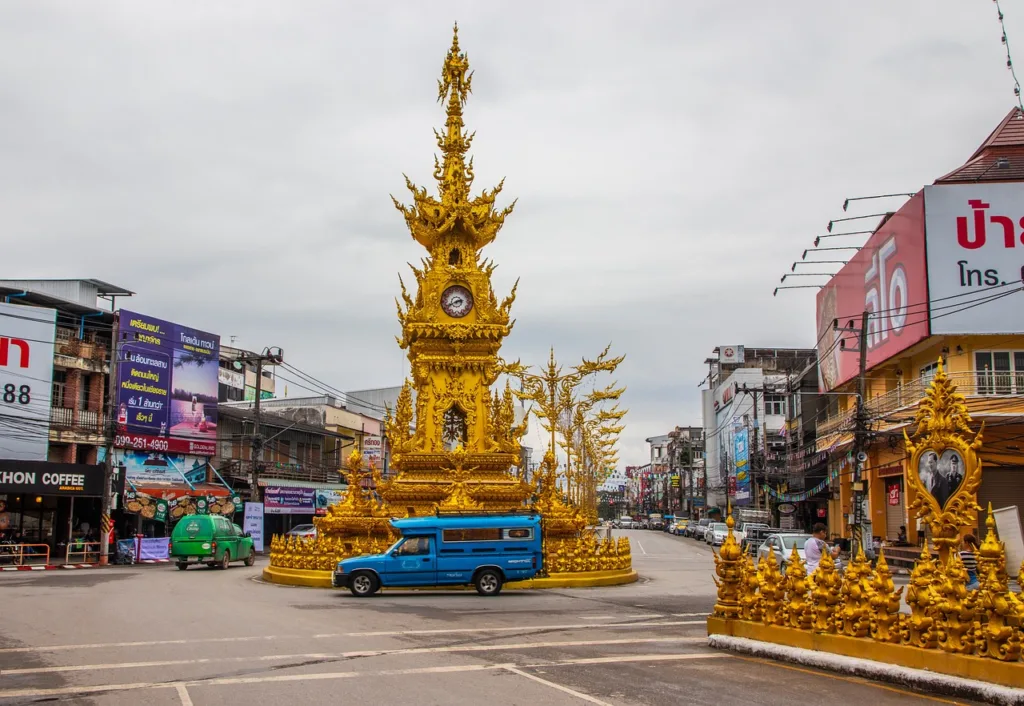
9. Chiang Rai Clock Tower
The Clock Tower is a prominent landmark in the heart of the city. The tower was built in 2008 to commemorate the 60th anniversary of King Rama IX’s ascension to the throne. The tower was designed by Thai artist Chalermchai Kositpipat (Yes, the very same one who did the Blue and White Temples).
The Clock Tower is decorated with intricate gold and every evening at 7:00 PM, 8:00 PM, and 9:00 PM, the tower comes to life with a light and sound show that lasts for about 10 minutes so if you’re ever in the area at those times be sure to drop by!
Cost: Free
10. Wat Phra Sing
Wat Phra Sing origins are a bit unclear, but it is believed to have been built in the 14th century and has since undergone several renovations and restorations.
The temple’s main hall houses the highly revered “Phra Singh,” Buddha statue.
The door panels of the Ubosot were decorated by the Chiang Rai-based artist Thawan Duchanee, and feature four animals that symbolize the four elements in the human body according to Thai belief: the snake represents earth, the Garuda bird represents air, the lion represents fire, and the elephant represents water.
Cost: Free

11. Singha Park
Singha Park covers an area of over 8,000 acres and is owned and operated by the Boon Rawd Brewery, which is known for producing the famous Singha beer!
It’s home to the iconic golden Singha statue. A Singha is a Thai mythical creature that is a combination of a lion’s body and a bird’s wings and beak.
It’s the very same logo you can find on the Singha beer, so the more you know!
Cost: Free
12. Oub Kham Museum
The Oub Kham Museum is a private museum that showcases a collection of traditional Lanna art and antiques. The museum was founded by Julasak Suriyachai, a descendant of the Lanna royal family.
The museum is housed in a beautifully restored traditional Lanna-style building, which was originally built in 1893.
Lanna was a medieval kingdom that existed in what is now northern Thailand from the 13th to the 18th century. The kingdom’s culture and architecture were heavily influenced by neighboring regions such as Burma, Laos, and China.
Cost: 300 THB (8.50 USD)
Top Things to Do in Chiang Rai

13. Drink Tea at the Choui Fong Tea Plantation
The Choui Fong Tea Plantation covers an area of over 1,000 acres and is known for producing some of the finest teas in Thailand.
The plantation offers guided tours that take you through the tea fields and explain the process of tea production, from the cultivation of the tea plants to the processing of the tea leaves. The Choui Fong Tea Plantation also has picturesque views that are best enjoyed with a cup of tea!
14. Get a Thai Massage
Getting a taste of Thai culture through a traditional Thai massage is always a must-do while you’re in Thailand! Chiang Rai will have much better rates compared to Bangkok and I recommend going out into the streets rather than getting one at your hotel.
I found our hotel’s rates were more expensive and shorter while the one I went to which was a short walk away was cheaper at around 200 THB (5 USD) and twice as long.
15. People Watch at Lilawadi Park
This was another hidden gem I discovered as I was walking to the Thai Massage parlor. Lilawadi Park is pretty unique because it’s not actually a park but an abandoned airplane runway that now functions as a park.
We passed through it during the day and it was empty but as the sun sets, it comes to life and is full of people doing all sorts of things from sports to just sitting down and chatting. It’s a very fun way to catch a glimpse into the local life.
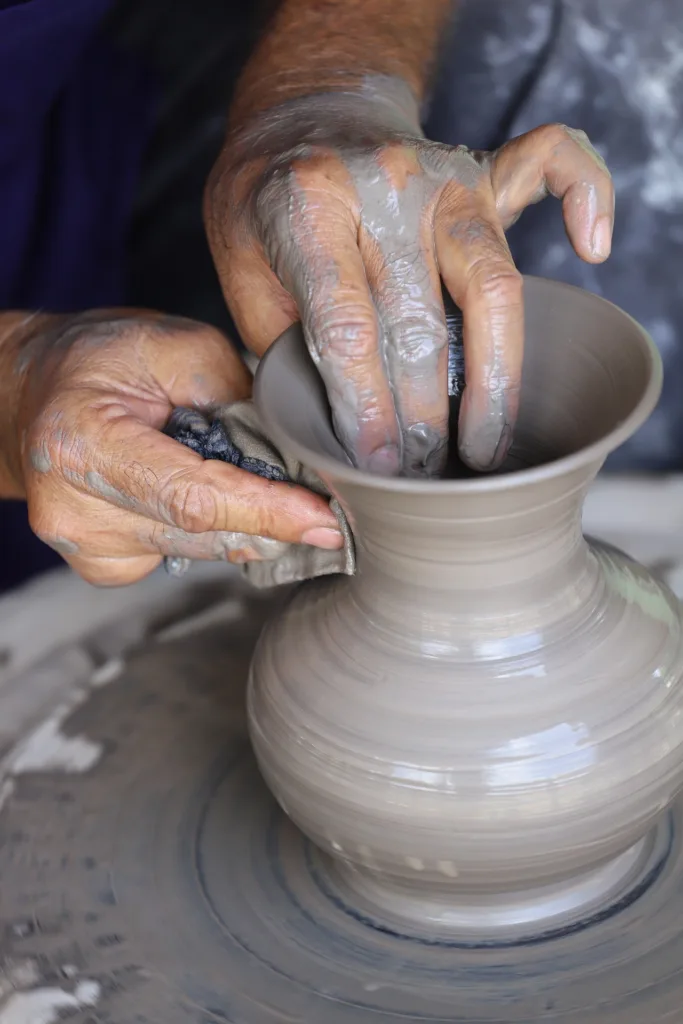
16. Try Your Hands at Doi Din Dang Pottery
Doi Din Dang Pottery is a small, family-owned pottery studio that does traditional Lanna-style pottery. You can learn ancient techniques that have been passed down through generations by taking part in workshops. You’ll go through the whole process of making pottery, from molding the clay to firing the finished piece in a kiln. It makes for an excellent souvenir to take back home!
17. Be in Three Countries at Once at the Golden Triangle
The Golden Triangle is where the borders of Thailand, Laos, and Myanmar meet. The area gets its name from being a major hub for the opium trade back in the day. It kinda explains why I was still seeing some opium tea in the “happy menus” of Vang Vieng.
But the blackmarket aside, nowadays people go there for the natural scenery and the monument that marks the spot where the borders of the three countries intersect.
You can join a tour that visits all the major temples in Chiang Rai as well as the Choui Fong Tea Plantation and Golden Triangle through here.

18. Go Trekking around Phu Chi Fa
Phu Chi Fa is one of Chiang Rai’s best-kept secrets.
It’s situated in the Doi Pha Mon mountain range and reaches a height of 1,628 m (5,341 ft). The area offers several viewpoints along a cliff path with stunning 360-degree views of the mountain ranges of Thailand and Laos.
If there’s one thing to see at Phu Chi Fa, it’s the view at sunrise. The mountain peaks rising above a sea of morning fog makes for such a dramatic sight. Along with a jagged cliff-top edge and a steep cliff-drop overlooking a valley below, you will be left in awe at the majesty of nature at its best.
19. Take a Dip at Pong Phra Bat Hot Springs
Pong Phra Bat Hot Springs is the perfect choice for relaxation after a day of adventure. The thermal baths are one thing but there are also private and public pools. You can also get a Thai massage here after swimming when your muscles are even more relaxed to end the day.
Where to Stay in Chiang Rai
Chiang Rai is a wonderful laid-back province with plenty of accommodations to suit your needs, here are some of my recommendations:
Best Hotels in Chiang Rai
- Pimann Inn Hotel – this is where we personally stayed and I must say it was more than enough for us. The air-conditioned rooms were spacious and quiet. The halls had a long koi pond extending both directions. Concierge service was good and they had a very huge pool. The location was also very good as it’s tucked in the heart of the city center.
- The Heritage Chiang Rai Hotel – a 5-star hotel that features an outdoor swimming pool, a fitness center, and a garden, as well as offering free private parking and free WiFi. The hotel also has a terrace with city views, a restaurant, and a bar.
- Blue Lagoon Hotel – offers shared lounge and concierge services, along with free WiFi. All rooms at the hotel come with air conditioning, a flat-screen cable TV, a fridge, an electric tea pot, a shower, free toiletries, and a desk. The private bathroom is equipped with a hairdryer and complimentary bed linen.
- Mercy Hostel – located a little off the main road, providing a peaceful sleeping environment. Also features a terrace with a small reflecting pool and sunbathing mattresses. The hostel has only one floor, so there is no need to climb stairs. The 10 dormitory rooms are air-conditioned and come with individual lockers, individual lights, hotel-quality beds, and blankets.
- Backpack Hostel – offers express check-in and check-out, non-smoking rooms, and free WiFi throughout the property. The hostel features a terrace and a tour desk, and luggage storage service is available. The rooms at Backpack Hostel are equipped with air conditioning and shared bathrooms.
- Baan Mai Kradan Hostel – is a renovated old Thai house built in 1964, located in the downtown area of Chiang Rai. The hostel was opened in October 2017 and provides premium co-living accommodation. The hostel is situated just a few minutes’ walk from the famous Saturday Walking Street.
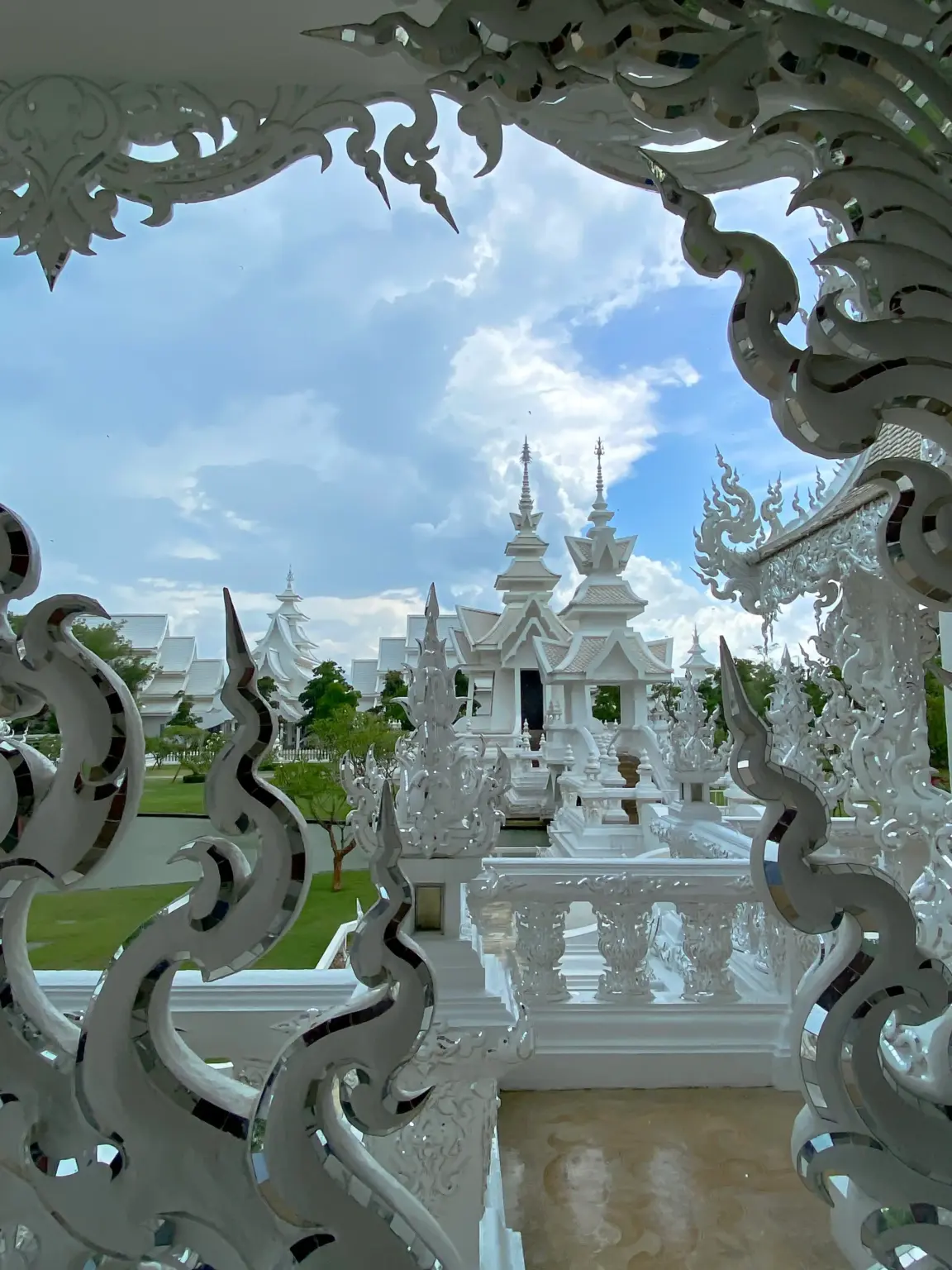
How to Get Around Chiang Rai
Most of the attractions around Chiang Rai are actually quite far from each other and would require some wheels, that being said here are some of the ways to get around Chiang Rai:
- Tuktuk: The classic three-wheelers, they can fit around 3 people and are generally inexpensive and prices are negotiable.
- Taxi: Our preferred method. Simply use the Grab app to call a cab and go attraction-hopping.
- Songthaew: Shared pickup trucks that are similar to the Jeepneys of the Philippines. They operate as a public transportation system and are the cheapest way to get around the city. They have a set route and charge a fixed fare so it’s best to familiarize yourself before getting on. We used them in Amphawa and found them to be very convenient.
- Car: You can also rent a car and visit the various places at your own leisure.
- Motorcycle: There are also motorbike rentals around Chiang Rai. The roads are quite safe and wide and the Thai are pretty safe drivers.
- Tour: Going by tour is also a great and fun way to see the sights around Chiang Rai. You can find various activities and tours to join through GetYourGuide.
How to Stay Safe in Chiang Rai
Chiang Rai is a relatively safe city. Much safer than Bangkok, I never felt any bad vibes even in the middle of the night. It’s really laid back and the people are very kind. But like any other destination, it’s important to take precautions to ensure a safe and enjoyable trip, I recommend getting travel insurance at least for that peace of mind.

Best Time to Visit Chiang Rai
The best time to visit Chiang Rai is during the cooler and drier months from November to February. During this time, the temperatures are mild, with average highs of around 24 – 26°C (75 – 79°F) and lows of 13 – 15°C (55 – 59°F). This is also the peak tourist season, so expect higher prices and more crowds.
The hot season from March to May can be uncomfortably hot, with temperatures reaching highs of around 34 – 36°C (93 – 97°F) and lows of 20 – 25°C (68 – 77°F).
The rainy season from June to October can be unpredictable, with sudden heavy rain and thunderstorms (I know, we experienced this first hand). The temperatures are slightly cooler during this time, with average highs of around 29 – 31°C (84 – 88°F) and lows of 20 – 23°C (68 – 73°F).
What to Pack For Chiang Rai
- Lightweight clothing: Pack breathable clothing as the weather can be hot and humid. Dress modestly when visiting temples as you might not be allowed in.
- Swimwear: Most hotels would have pools, not to mention the waterfalls and hotsprings around Chiang Rai!
- Rain gear: During the rainy season, heavy downpours come as fast as they go but if you’re caught unprepared, well…prepare to get soaked.
- Sun protection: Not much shade in Chiang Rai, so best to bring some sunscreen or an umbrella during the summer months.
- Insect repellent: Mosquitoes are quite common during the rainy season.
- Adapter: Thailand uses Type A, B, C, and F electrical outlets
Plan Your Trip to Chiang Rai | Best Travel Resources
Book Your Accommodations
- Booking.com – the world’s leading online booking platform for accomodations around the world, they have an extensive amount of available listings with zero booking fees and best price guarantees.
- Hostelworld – a backpacker’s best friend, Hostelworld has the largest collection of hostels and guesthouses for affordable prices.
Don’t Forget Insurance
- SafetyWing – from Nomad Insurance, an insurance by nomads for nomads. They understand our lifestyle well and have really comprehensive and flexible plans that cater to any traveler.
Find Cheap Flights
- Kiwi.com – my go-to for booking and finding the cheapest flights and it’s helped me save tons of money. They do virtual interlining which is connecting flights from airlines that do not codeshare, so you can find routes that you wouldn’t be able to find normally.
Join Tours & Activities
- GetYourGuide – is one of the best places to find unique tours and activities. I found that it’s an excellent way to meet fellow travelers and create fond memories. They are not only limited to tours as they also offer niche services such as skip-the-line tickets or private transfers.
Catch a Ride
- Rentalcars.com – nothing beats the freedom of the road, Rentalcars.com is the world’s largest online car rental service. They operate across 160 countries so they’re the perfect partner to work with if you find yourself wanting a ride.

